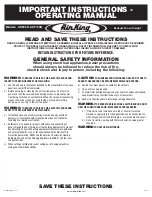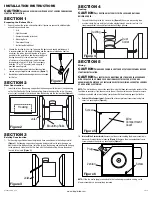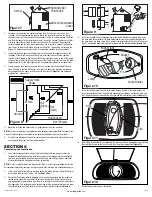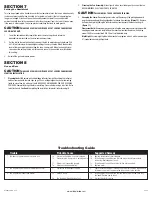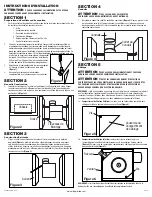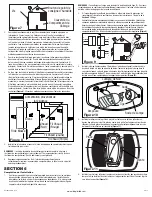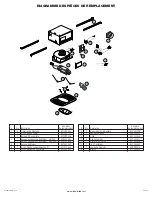
INSTALLATION INSTRUCTIONS
CAUTION:
MAKE SURE POWER IS SWITCHED OFF AT SERVICE PANEL BEFORE
STARTING INSTALLATION.
SECTION 1
Preparing the Exhaust Fan
1. Unpack fan from the carton and confirm that all pieces are present. In addition to the
exhaust fan you should have:
1 - Grill
1 - Light Assembly
1 - Damper Assembly (attached)
4 - Mounting Rails
1 - Fluorescent Lamp
1 - Instruction/Safety Sheet
2.
Choose the location for your fan. To ensure the best air and sound performance, it
is recommended that the length of ducting and the number of elbows be kept to a
minimum, the radius of each elbow be as large as
possible for the installation, and that insulated hard
ducting be used. This fan will require at least 8”
of clearance in the ceiling or wall, and will mount
through drywall up to 3/4” thick. The fan mounts
between 16” or 24” on center joists using the 4
provided mounting rails.
3.
Select the most convenient electrical knockout and
remove using a straight-blade screw driver
(Figure 1).
4.
No additional vibration deadening materials are needed
for this fan.
SECTION 2
New Construction
1. Install the rails on the housing and position the housing next to the joist. Line up housing
so that it will be flush with the finished ceiling. Secure the ends of the rails with screws
or nails (not included) to the joists and slide the housing into the final position
(Figure 2).
SECTION 3
Existing Construction
1. Set housing in position between the joist and trace an outline onto the ceiling material
(Figure 3)
. Set housing aside and cut opening, being careful not to cut or damage any
electrical or other hidden utilities. Install the rails on the housing and position the housing
in the previously cut hole so that it is flush with the finished ceiling. Secure the ends of
the rails to the joists
(Figure 2).
www.airkinglimited.com
6728023 Rev. G 5-14
2 of 12
SECTION 4
Ducting
CAUTION:
ALL DUCTING MUST COMPLY WITH LOCAL AND NATIONAL
BUILDING CODES.
1. Connect the ducting to the fan’s duct collar
(Figure 4)
. Secure in place using tape
or screw clamp. Always duct the fan to the outside through a wall or roof cap. It is
recommended that low restriction termination fittings be used.
SECTION 5
Wiring
CAUTION:
MAKE SURE POWER IS SWITCHED OFF AT SERVICE PANEL BEFORE
STARTING INSTALLATION.
CAUTION:
ALL ELECTRICAL CONNECTIONS MUST BE MADE IN ACCORDANCE
WITH LOCAL CODES, ORDINANCES, OR NATIONAL ELECTRICAL CODE. IF YOU ARE
UNFAMILIAR WITH METHODS OF INSTALLING ELECTRICAL WIRING, SECURE THE SERVICES
OF A QUALIFIED ELECTRICIAN.
NOTE:
This unit includes a side access panel for wiring that does not require the removal of the
fan’s blower assembly. If you choose to wire the unit from the inside, you will need to remove
the blower assembly and internal wiring compartment. Both methods are equally effective.
1a.
External Wire Compartment:
Remove the wire compartment cover screw and place
cover in a secure place
(Figure 5)
.
1b.
Internal Wire Compartment:
Remove the three screws holding the blower assembly in
place and lift assembly out of housing
(Figure 6)
. Remove the wire compartment cover
screw and place the cover in a secure place
(Figure 7).
NOTE:
If the fan motor plug is connected to the fan housing receptacle, unplug so the
blower assembly can be completely removed.
Figure 1
Figure 5
Screw
Wire
Compartment
Cover
Figure 2
Housing
Joist
Mounting Rails
Ducting
Duct
Collar
Figure 4
Figure 3
Joist
Figure 6
Screw
Plug
Venturi

